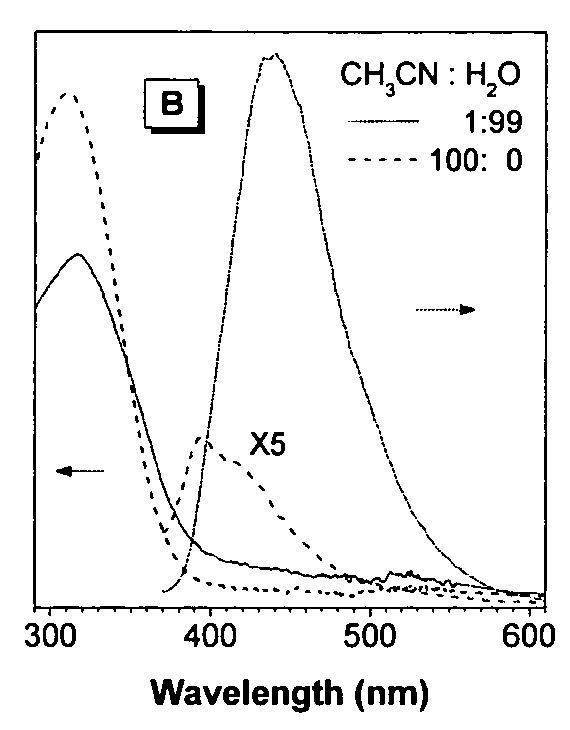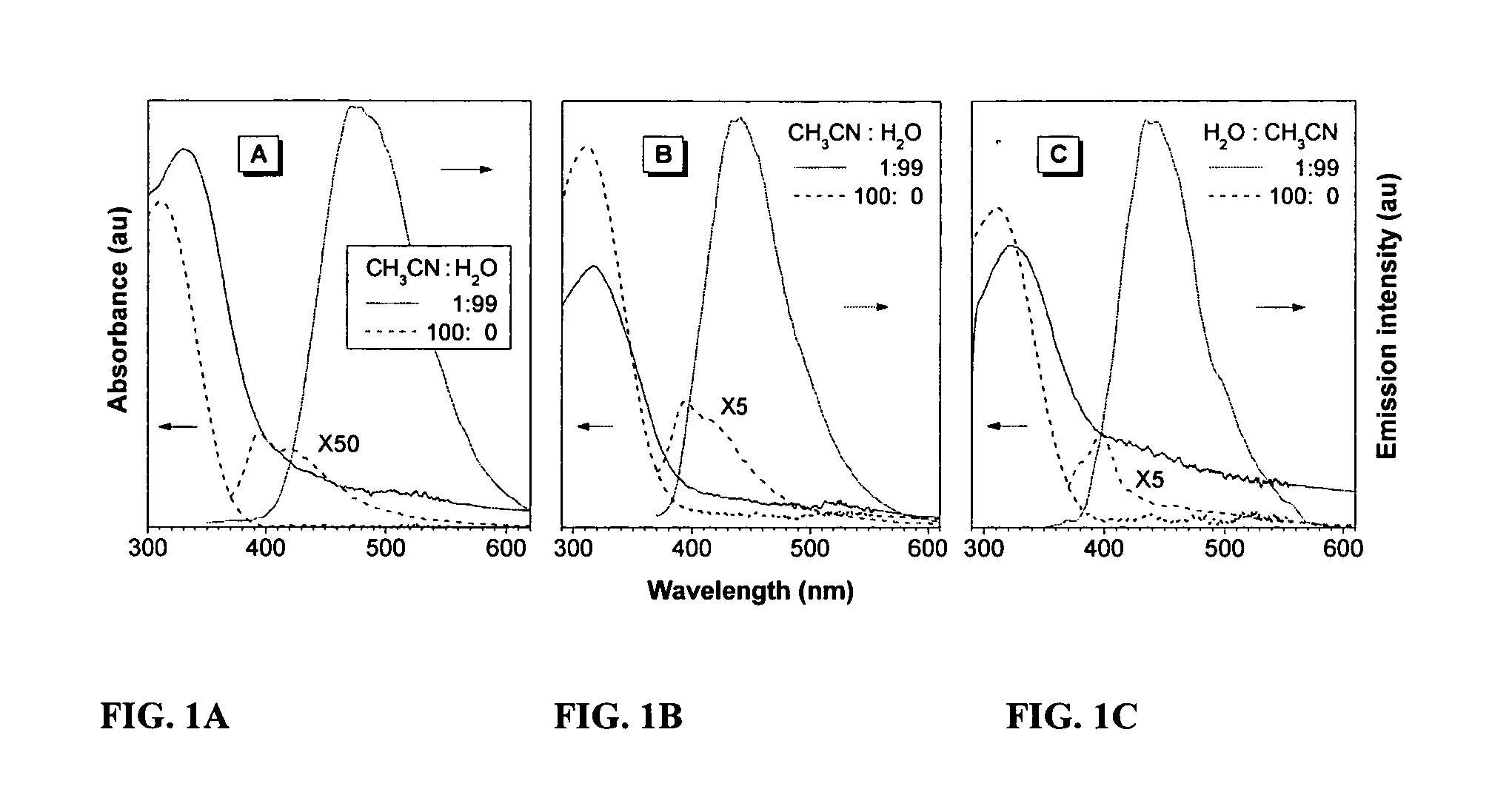Fluorescent water-soluble conjugated polyene compounds that exhibit aggregation induced emission and methods of making and using same
- Summary
- Abstract
- Description
- Claims
- Application Information
AI Technical Summary
Benefits of technology
Problems solved by technology
Method used
Image
Examples
example 1
1,2-Bis(4-hydroxyphenyl)-I,2-diphenylethylene (TPE-OH)
[0161]
[0162]A suspension of p-methoxybenzophenone (1.06 g, 5.0 mmol), 1.34 equiv of TiCl3 / AlCl3 (5.81 g, 6.7 mmol), and 25 equiv of Zn dust (8.01 g, 122.0 mmol) in 100 ml of dry THF was refluxed for 20 h. The reaction mixture was cooled to room temperature and filtered. The filtrates were evaporated and the crude product was purified by a silica gel column using hexane as eluent. 1,2-Bis(4-methoxyphenyl)-1,2-diphenylethene (TPE-OMe) was isolated in 91% yield.
[0163]TPE-OMe (1.40 g, 3.56 mmol) was dissolved in 20 ml of dichloromethane (DCM) in a 100 ml flask, and the flask was placed in an acetone-dry ice bath at −78° C. A solution of 3.59 g (14.3 mmol) of boron tribromide in 10 ml of DCM was added carefully to the mixture under stirring. The resultant mixture was allowed to warm to room temperature overnight under stirring. The reaction product was hydrolyzed by careful shaking with 20 ml of water. The organic phase was separated ...
example 2
1,2-Diphenyl-1,2-bis(4,4′-(3-sulfonato)propoxyl)phenylethylene (TPE-SO3)
[0166]
[0167]Into a 100 m round-bottom flask were added TPE-OH (0.5 g, 1.37 mmol) and 20 m of anhydrous ethanol under nitrogen. The mixture was stirred until all solids disappeared. A mixture of NaOEt (0.20 g, 3.0 mmol) in 20 ml ethanol was added dropwise and stirred for 1 h, causing the colorless solution to turn orange-red. Into the solution was added 0.35 g of 1,3-propanesultone (2.88 mmol) in 20 m of ethanol. The mixture was vigorously stirred for 12 h and a white product precipitated out from the solution. The product was collected by filtration and washed with ethanol and acetone twice to give a white solid in 61% yield.
[0168]Characterization data of TPE-SO3: 1H NMR (DMSO-d6, 300 MHz) δ (ppm): 7.25-7.13 (m, 6H), 7.08-7.02 (m, 4H), 6.95-6.90 (m, 4H), 6.81-6.73 (m, 4H), 4.09-4.02 (m, 4H), 2.66-2.58 (m, 4H), 2.08-2.02 (m, 4H). 13C NMR (DMSO-d6, 75 MHz) δ (ppm): 157.0, 143.9, 139.2, 135.5, 131.9, 130.8, 127.8, ...
example 3
N,N′-[1,2-Diphenyl-1,2-bis(1,4-phenoxyethyl)vinyl]bis(triethylammonium bromide) (TPE-C2N+)
[0169]
[0170]To a mixture of sodium hydride (84 mg) and 1,2-bis(4-hydroxyphenyl)-1,2-diphenylethene (0.50 g) in dry dioxane (20 ml), 1,2-dibromoethane (1.50 g) was added at room temperature. The mixture was heated to reflux and stirred for 24 h. After filtration and concentration, the product was isolated and purified by silica gel chromatography using chloroform / hexane (1:1 v / v) as elute. 1,2-Bis[4-(2-bromoethoxy)phenyl]-1,2-diphenylethene (TPE-C2Br) was obtained in 32% yield.
[0171]A 250 ml flask with a magnetic spin bar was charged with TPE-C2Br (100 mg) dissolved in 100 ml of THF. To this solution was added triethylamine (5 ml). The mixture was heated to reflux and stirred for 3 days. During this period, 10 ml of water was added at several intervals. THF and extra triethylamine were evaporated. The water solution was washed by chloroform three times. After solvent evaporation, the residue was...
PUM
| Property | Measurement | Unit |
|---|---|---|
| Fraction | aaaaa | aaaaa |
| Length | aaaaa | aaaaa |
| Length | aaaaa | aaaaa |
Abstract
Description
Claims
Application Information
 Login to View More
Login to View More - R&D
- Intellectual Property
- Life Sciences
- Materials
- Tech Scout
- Unparalleled Data Quality
- Higher Quality Content
- 60% Fewer Hallucinations
Browse by: Latest US Patents, China's latest patents, Technical Efficacy Thesaurus, Application Domain, Technology Topic, Popular Technical Reports.
© 2025 PatSnap. All rights reserved.Legal|Privacy policy|Modern Slavery Act Transparency Statement|Sitemap|About US| Contact US: help@patsnap.com



